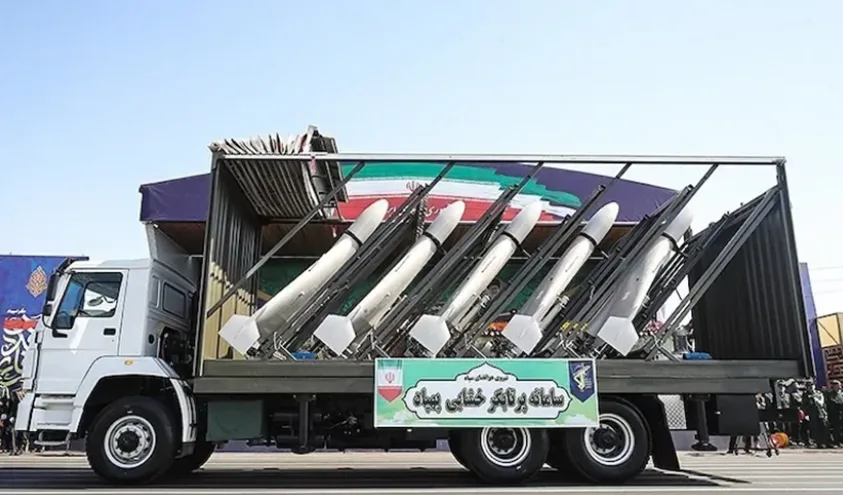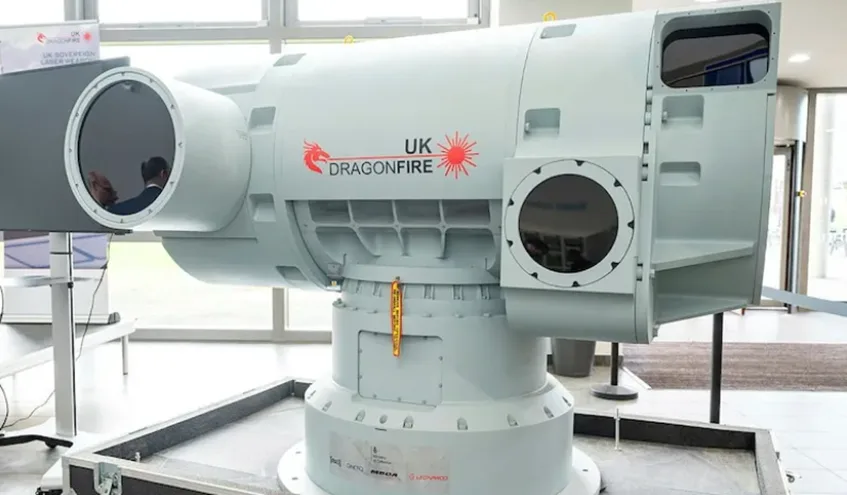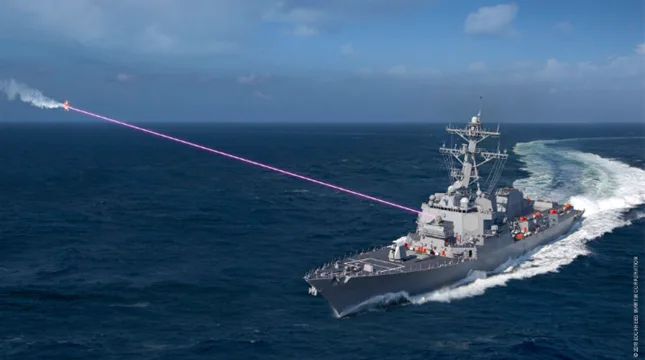This Week in Laser News – What’s Going on With HELs (Week of January 13th 2025)
This week, a detailed analysis of the legalities of laser weapon system employment, Rheinmetall and MBDA team up for making German laser weapon systems, Iran now has lasers?, and the U.S. Navy leadership is embarrassed by the state of naval laser development.
News roundup by Caleb Hoover
Friday January 10th 2025
Saved Round (This article is technically from last week, but it’s worth mentioning since I found it late)
Article Info
Lieber Institute of West Point has a blog titled Articles of War that coverers topics such as William H. Boothby’s article titled “The Drone Threat, The Laser Response, and The Law – Part 1”.
Article Summary
Boothby begins with a discussion on the new prevalence that one way attack kamikaze drones are now having in the modern battle space. These weapons operate in a manner akin to cruise missile but notably have longer loitering times thanks to the fact they often take on some of the endurance characteristics of fixed wing propeller aircraft. Defining drones that have this kamikaze-like method of employment as “loitering munitions” is also becoming common.
After laying this groundwork Boothby then proceeds to discuss how these relatively new weapons systems fit into the framework of the law of war. Generally speaking, Boothby concludes that the use of kamikaze drones do not violate some of the key principles of “not causing any unnecessary suffering for which there is no corresponding military purpose”. So in accordance with Article 22 of the Hague Regulations of 1907, it seems these drones do not “per se, breach international law.
After outlining the first principle, Boothby discusses a second stipulation outlined in Additional Protocol I, Article 51(4)(b) and (c). This prohibits the use of weapons that are indiscriminate by nature. The critical need here is that there can be an assurance that the pilot in command of these drones is able to ensure that strikes are only on lawful military targets. The final principle of considering environmental impact of the weapon isn’t discussed by Boothby as he points out that this would be entirely dependent on the warhead’s contents. So, in Boothby’s view, the main concern for using kamikaze drones would likely be if for some reason employing these drones as part of a swarm led to the weapon system becoming indiscriminate in its targeting process.
The article concludes with a discussion of targeting law rules as set forth in Article 48 of Additional Protocol I. Boothby includes this quote as a good summary of the targeting legalities in play:
“In order to ensure respect for and protection of the civilian population and civilian objects, the Parties to the conflict shall at all times distinguish between the civilian population and combatants and between civilian objects and military objectives and accordingly shall direct their operations only against military objectives.”
At the very end, Boothby leaves us with the cliffhanger:
“The focus of the discussion should now turn to the ways in which the drone threat discussed in the preceding sections might be countered using laser technology, and that is the subject of Part II of this post.”
Luckily the Part II of this article dropped on January 13th so we have it in this week’s round up too.
Image caption from the article: A truck (Picture source: Articles of War)

Sunday January 12th 2025
Article Info
This week, MilitarNYI released an article titled “Rheinmetall and MBDA to form joint venture to develop laser weapons”
Article Summary
Rheinmetall and MBDA successfully navigated the approval process with the German antitrust authorities to work together on a joint venture. This application was submitted in December 2024 and has already received approval. The companies worked together on an earlier project to produce a demonstrator which was mounted to a Sachsen frigate. This example system used a total of (12) 2 kW lasers to generate a combined power level of 20 kW. Systems made with this beam combining technique offer a theoretical fast track toward scalability. In the case of this demonstrator achieving a power level of 100 kW is viewed as possible.
During the development, the demonstrator fired over 100 test shots destroying UAVs at “short” and “extremely short” distances. Between MBDA and Rheinmetall, most of the laser related tasks seem to fall with MBDA. For Rheinmetall’s part, the container design and electrical integration will be their main contributions.
Article image: Demonstrators of the German naval laser system (Photo Credit: Indian Defence Review)

Monday JaN 13th 2025
Article Info
Lieber Institute of West Point has a blog titled Articles of War that coverers topics such as William H. Boothby’s article titled “The Drone Threat, The Laser Response, and The Law – Part 2”.
Article Summary
Boothby completes a recap of Part I and then starts discussing how various traditional anti-aircraft weapon systems are being used effectively for these loitering munitions drones. An exception to this rule is also introduced in the instances that these drones are massed for swarm attacks with multiple drones attacking at the same time. Newton’s third law of every action has an equal and opposite reaction, yet Boothby states that that analogy might not completely fit what we’re seeing with ubiquitous drone usage and the active pursuit of countermeasures to defend against them.
Boothby cites reports from DefenseNews, Aljazeera, and Politico that reference the use of the Avenger air defense system using Stinger missiles, Patriot systems, the Iris-T system, and a number of machine gun and anti-aircraft solutions for taking out the drones. Boothby then cites a series of prominent laser weapon systems such as S. Korea’s Skylight system, the UK’s Dragonfire system, and Israel’s Iron Beam system.
Patriot Video
Iris-t Video
Ukrainian Engagement of Drones with a gun
After presenting this comparison, Boothby goes into an analysis that first covers whether or not laser employment for neutralizing drones, missiles, rockets, and mortars may be considered legal engagements in accordance to Additional Protocol I. Since these systems would in principle not have a human on the platform, he concludes that superfluous injury or unnecessary suffering would not be a result of lasers employed in this way.
The next legal matter considered is whether lasers are indiscriminate in nature when employed. Generally, the performance of lasers at different tests suggest that they can fit well into this legal framework since they offer a high degree of targeting precisions. Test shots should be scrutinized to determine if there are instances where this level of precision is hampered and leads to unintended instances of laser energy failing to hit intended target areas.
The third legal matter of considering environmental impact in accordance with Articles 35(3) and 55 of Additional Protocol I seems to be a safe bet with laser employment. Boothby mentions “The only rules of international law that specifically address laser weapons are to be found in Protocol IV to the Conventional Weapons Convention. Article 1 of that treaty prohibits the employment of laser weapons specifically designed as a combat function to cause permanent blindness to unenhanced vision. It is most unlikely that weapons of the kind being discussed in this post will be so designed.”
Boothby then concludes the article with a discussion of concerns relating a commonly sought effective engagement range of 4.3 km equating to 14,107 feet of altitude. Usage of lasers for anti air would need to factor in the continuous propagation of beams out to that effective range. This is where the application of what I learned as the 5th weapons safety rule of “know your target and what lies between it and beyond it” is especially applicable. Boothby mentions that tools such as Notice to Airmen could be useful in keeping laser engagement corridors clear of civilian air traffic.
Image caption from the article: a closeup view of the UK’s Dragonfire Laser(Picture source: Articles of War)

TUesday Jan 14th 2025
Article Info
India.com published an article by Joy Pillai this week titled “Bad News for Israel, US as Iran develops super powerful laser defence system, deploys it too…”.
Article Summary
Amid fears that its nuclear facilities might be targeted in the near future, Iran has reportedly deployed laser defense systems. These systems are expected to be able to target low flying drones. The system is named Seraj (which translates to “light”) and was apparently on display near the Fordow Uranium enrichment facility
Iran is claiming that their Seraj system is able to match Israel’s capabilities in this area. Apparently, some defense drills have been conducted at the behest of Iran’s Supreme Leader Ayatolla Seyyed Ali Khameni.
Video on the Fordow facility
article scout
Special thanks to Benjamin Johnson for bringing this article to my attention in his LinkedIn post
My Hot Take on this Article
I’m not sure the US and Israel’s strike methodologies of choice leave them vulnerable to these sorts of defensive platforms. As Benjamin mentions in his post, this system is likely in the 10 – 30 kW class. I think we might opt for manned aircraft flights at high altitude for targeting. I suspect we could keep our airframes higher than the Seraj’s threat bubble. That take aside, I still think it is interesting that Iran has now entered the laser weapon system’s game. We’ll definitely need to be on the lookout for further developments.
Wednesday January 15th 2025
Article Info
Breaking Defense published an article by Justin Katz this week titled “State of Navy’s shipboard laser efforts is embarrassing, says top fleet commander”.
Article Summary
This article has numerous quotes from Navy leadership. They remark that lasers are simply not progressing fast enough on the naval employment front. For one, Adm. Daryl Caudle, commander of US Fleet Forces Command states:
“There’s been many a thesis and dissertation written on building lasers on ships, but we’ve not transitioned that into a place where that’s an acceptable way to actually take out missile systems,”
Rear Adm. Fred Pyle had this to say:
“Sometimes we have a tendency to over promise and under deliver. We need to flip that to where, when we’re intellectually honest, when we’re honest with ourselves from a technology capability, that we have an agreed upon sight picture of what it’s going to look like to deliver that capability.”
The article closes out with this quote from Adm. Caudle:
“I just think sometimes something can stare us right in the face, but we just don’t go do it. Directed energy is one of those things that either industry, politically, leadership — we’re just not on the same page of getting behind it with a sense of urgency and making it ready to go.”
Article Scout
Special thanks to Benjamin Johnson for his LinkedIn post on this article!
My Hot Take on this Article
Donald Rumsfeld made a quote back in 2004 (when I was in high school): “you go to war with the army you have, not the army you might want or wish to have at a later time” Thanks, ChatGPT, for helping me find the source. I think there is an interesting degree of institutional inertia that is causing the industry, political institutions, and leadership to not sync up on laser weapon systems.
For example, Admiral Caudle’s statement declaring missile neutralization as a key requirement for laser weapon systems mounted on ships illustrates this misalignment. I think there is a systemic problem within the Navy—and likely the entire DoD—when they insist on lasers being able to address missile threats. Meanwhile, the Army appears to have course-corrected in their 2024 request for industry to develop laser systems capable of neutralizing Class III UAS threats. This shift reflects the wisdom of Rumsfeld’s quote from over 20 years ago.
Institutional inertia in the DoD is causing the branches of the U.S. military to have a “failure to see the forest through the trees.” The emphasis on missile defense is causing key leaders to lose sight of what today’s laser systems are already capable of achieving. What if a peer-level adversary were to forgo expensive missile strikes and instead bias their attacks toward using kamikaze drones? This could present an extremely tough challenge for us, given the poor exchange ratio we would face with our current weapon systems. Drones are cheap, and the ordnance we have in operation today to intercept them is expensive.
It is at our own peril that we allow this misalignment to persist. By failing to adapt to the threats we’re already facing—and prioritizing legacy concepts of warfare over present capabilities—we risk falling behind in an era where cost-effective and scalable solutions are paramount.
Article Image: A concept drawing of Lockheed Martin’s HELIOS weapon system for the US Navy. (photo courtesy of Lockheed Martin)

That’s all for this week. Keep reading or check back for updates.
